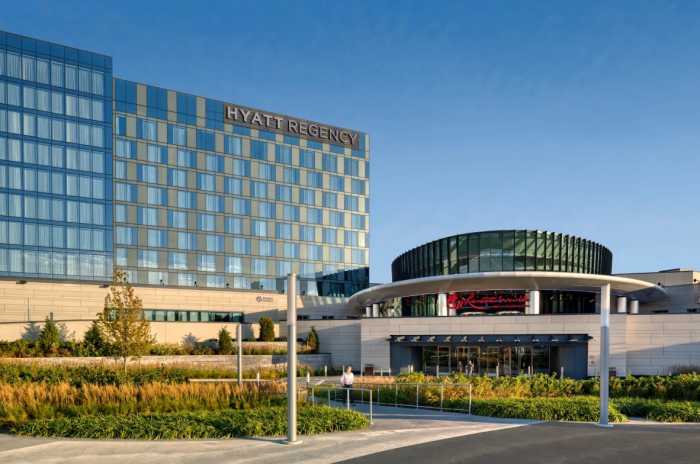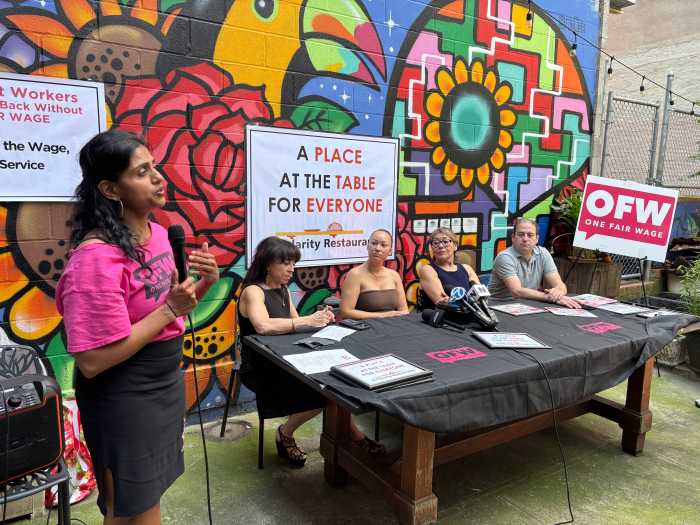Anyone who has passed through the west side of Manhattan lately knows it’s been taken over by cranes, construction, hard hats and bright vests. But this industrial landscape is transforming into one of the most advanced urban centers in New York City.
A campus of over 10 towers, a shopping center, a culture shed and a public school will comprise the Hudson Yards when it is completed in 2024, and around half its space will be designated for public use.
Much of the construction amounts to a multi-tasking effort as structures are built atop brand new platforms.
“We’re doing everything at once,” said Michael Samuelian, vice president at Related Companies, one of the developers. “We are digging in dirt and drilling into the ground and we’re also doing finishing work for Coach today. Very few projects have to do everything simultaneously.”
The first skyscraper, 10 Hudson Yards, is merely five months from opening following three years of development. The 1.7 million square-foot, 52-floor commercial tower, developed by Related Companies and Oxford Properties, was topped out on Oct. 7 with suit-clad developers and hard-hatted construction workers celebrating the watershed moment.
While Hudson Yards covers 30th Street to 42nd Street, most of the attention has been on the future neighborhood that will span from 30th Street to 34th Street between 10th Avenue and the West Side Highway.
“As you look around you can get a sense of the scale and magnitude of what we’re creating here,” said Ronald Wackrow, executive vice president of Related Companies, at the Oct. 7 ceremony.
The project is the largest private development in the U.S. in terms of square footage and dollars, according to Related Companies.
Commercial space
With a bill of $20 billion, the project will create over 17 million gross square feet over a trainyard that houses LIRR and New Jersey Transit trains.
Approximately 10 million gross square footage in Hudson Yards will be dedicated to office space, rivaling entire cities. (By comparison, Hartford, Connecticut, and San Diego each have approximately 9.9 million gross square footage of office space.)
Most of the construction has so far been done in the eastern section of the yards, which will be predominately commercial. All of the towers will be completed at different times, with the first tower set to open in March 2016, the retail and public space slated for a 2018 opening, and the entire yard completed in 2019.
Coach, L’Oreal and Time Warner are just a few of the corporate tenants committed to moving to the yards within the next few years. In addition, luxury department store Neiman Marcus announced it will open a three-level store in the shopping center of the Eastern Yard, and space for dozens more businesses and restaurants will be available.
More than 14,000 office and retail jobs, along with 7,500 construction jobs, have been generated by the redevelopment of the Hudson Yards, according to a representative at the NYC Economic Development Corporation. In 2002, the city estimated that nearly 23,000 construction jobs will be created by the end of Related Companies’ development.
Construction hurdles
The MTA last month opened its expansion of the No. 7 line. Several city agencies have also been working to redevelop the area in cooperation with Related’s construction teams. Related and the Long Island Railroad have been working with developers in the construction of platforms over the train yards. Complicating things has been Amtrak’s Gateway Project, which will add two track tunnels under the Hudson River that reach into the Hudson Yards. New York’s Department of Environmental Protection is also working to connect Water Tunnel No. 3 on the corner of 30th Street and 10th Avenue.
“All of this has created a fairly complex site which is likely going to remain that way for quite some time,” said Adam Ganser, the vice president of planning and design at the High Line, who has collaborated with Related’s construction team on extending the city’s western walkway into the Hudson Yards.
“But for them to be able to move forward at the pace that they’re moving and hitting their target, at least as close as they are, I think they’re doing a fairly good job on their schedule,” Ganser added.
New York City has also played a hand in the redevelopment through a $3 billion investment, of which $2.4 billion went toward the extension of the No. 7. Former Mayor Michael Bloomberg’s administration led the decision to make the investment and it is estimated that the Hudson Yards Terminal Station will serve 56,000 riders per day by 2025.
New Yorkers have also paid in some respects. Several businesses were relocated by the city to make room for the Hudson Park and Boulevard to make room for the development and nearby residents have been dealing with incessant construction noise, which also goes on at night.
Christine Berthet, chairwoman of Community Board 5, said that because the platforms are being built atop a train yard, the construction crews have to work when the trains are least active. “We just conducted a survey and noise and construction are very high concerns in the community,” Berthet said. “[The development] has been very disruptive.”
The city has said the development will raise over $3 billion a year through taxes and other streams of revenue by the time it is is complete.
Housing
Much of what the developers have in store for the residential component of the project is still under wraps. Out of the 5,000 residential units that will be built by Related Companies, 431 will be dedicated to affordable housing.
Mark Spector, president of the Hudson Yards Development Corporation, has helped oversee work within and beyond Related Companies’ development and said that securing affordable housing has been a major goal of both the current and former administrations.
“It’s important that we have a strong commercial core to Hudson Yards,” Spector said. “It is a mixed-use district and having residential developments and affordable housing is really in spirit of that vision.”
Rent prices and the types of apartments being built haven’t been announced, but there have been hints of amenities at the towers, including the first-ever Equinox-branded hotel inside 35 Hudson Yards. Some 137 apartments available for sale will have access to the hotel’s perks.
Residents of 15 Hudson Yards will get an Equinox fitness center of their own, a 24/7 concierge-attended lobby, pet services and VIP access popular nightclubs including Marquee, Avenue and Dream Downtown.
A culture shed that will host hundreds of events,including New York Fashion Week, will also be on the premises.
The public school that will be built in the Western Yard will have 750 seats available, for grades K-8. The Department of Education hasn’t announced which district the school will be designated to or when it will open.






































